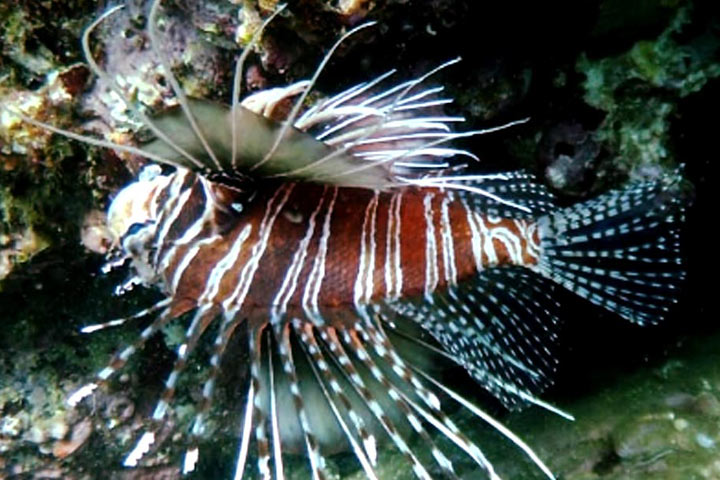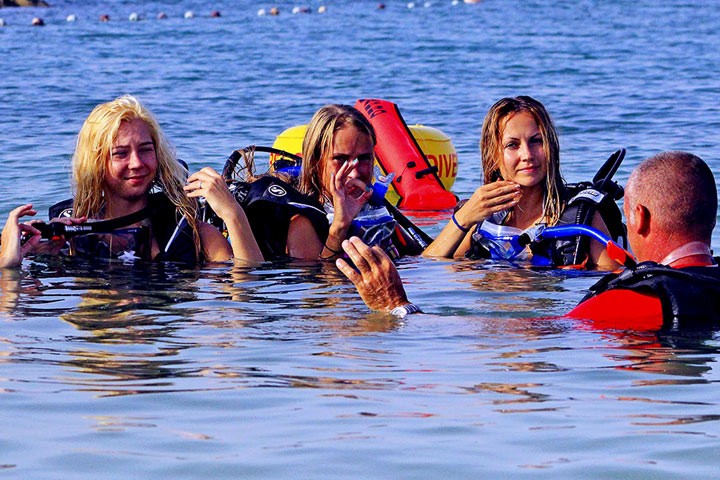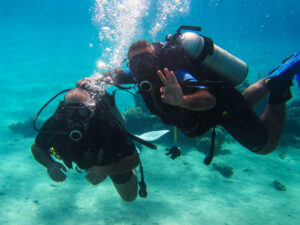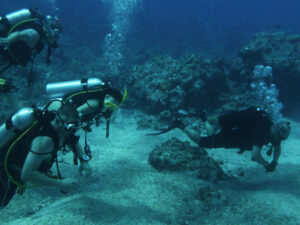Scuba Diving Boat Dive
Much of the world’s best scuba diving is accessible only by boat. Scuba diving from a boat is fun and relatively easy because you usually descend directly onto your dive site.
The shorelines and reefs of Fujairah are considered untouched and It has some of the most fascinating views in the UAE. Scuba diving in Fujairah is a great water sports activity for divers who are looking for adventurous activity, underwater fun, natural scenic beauty.
Scuba Diving in Fujairah is spectacular having the chance to spot whale sharks, mantas, zebra sharks, turtles and much more. Visibility sometimes can reach up to 30m and it is the best in UAE with water temperature ranging from 20℃ to 35℃ in July and August. Dive sites suitable for all levels ranging from shallow to deep dives.
Scuba Diving in Fujairah
Scuba Divers who are passionate about discovering the best dive spots of Fujairah Indian Ocean. Here are the diving spots in Fujairah.
Inchcape 1 consists of three wide pinnacles in close proximity with a crack running along the top and is about 150 m long and 100 m deep.
Inchcape 1 almost always delivers Sea Turtles and Cuttle Fish and very nice Jaw Fish. Inchcape 1 is full of shoaling fish and it also has Banner Fish, Parrot Fish, and Puffers shoals.
Inch 2, sunk as an artificial reef in 2002, and donated to us by Inchcape Shipping Services, lies opposite Martini Wall. She was a surface supply vessel, and lies on a sandy sea floor in an upright position. Cyclone Gonu broke her wheelhouse in 2007 so we are now referring to her as the big mettle canoe.
This is an unusual wreck noted for Nudibranches with at least 20 different species found on her, as well as the shoaling Fusiliers and huge Puffer Fish. Even she is used for our Wreck Diving courses and if you wanted to penetrate her for up to 20 m you would have the opportunity.
A pinnacle stretching 200 m lies beneath the surface and this is what we are going to be following on the dive.
The first part of the pinnacle will be a steep wall that will take you down to the site ‘s deepest area. You’ll see tropical marine life on top, and perhaps the Devil Rays shoal.
The second part of the dive around the island is a gentler sloping wall which ends in a mountain coral wall. Here you’ll see Black Tips, Turtles and many species of tropical fish, and it’s a great place to make a safety stop.
The site consists of three wide pinnacles in close proximity with a crack running along the top and is about 150 m long and 100 m deep. There’s a 4th rock as well but we don’t dive this on a standard dive schedule, but on occasions the more experienced divers will go here.
Sharm Rocks almost always delivers Sea Turtles and Cuttle Fish and very nice Jaw Fish. Sharm Rocks is full of shoaling fish and it also has Banner Fish, Parrot Fish, and Puffers shoals.
The main rock runs 130 m below the surface so it’s a big site that takes about 40 minutes to swim round non-stop.
The hole is a swim through a length of about 15 m and a height of about 1.5 m 3 m deep, making it an overhead setting. You can have to give way to the rays or tortoises inside the opening. You may see some large Rays in the sand on the deeper portion of the dive and if you go any further you’ll see Seahorses and Nudibranches.
The rock itself is about 160 m in length and is composed of two pinnacles at the widest point 80 m across.
A lot of shoaling at this site from Arabian Mackerel, Trevally, Sergeant Major’s, Fusiliers and Domino Damsel Fish. Look closer, among whip coral and teddy bear coral you’ll find Nudibranches, Cowrie Shells and various shrimps and crabs. Including the Porcupine Puffer, Moray Eels, Jaw Fish, Green and Hawks Bill Turtles and Barracuda, it is also home to some larger marine life.
A large number of cars and trucks (about 200) sunk in the 80’s to make a reef for the area’s fishermen.
The area has shrunk to around 60 square meters and 50 cars through the years and 2 cyclones. There are several wrecks in the outskirts of the site that shelter incredible marine life but these cars are usually dived by those who really know the location, the main site is where we can drop you near the Waffle (a big square wreck that resembles a waffle).
Great photography and discovery site and has an eco system for every ruin! The marine life is an Indian Ocean but at this site we also have Sea Horses, Rays, and Whale Sharks.
The wall consists of large granite rocks and is a 250 m swim, hard corals near the shore, while hard corals cover a wide area of about 200 m in the bay.
The site has plenty of shoaling fish like Cornet Carp, Trevally, Mackerel, Fusiliers, Sergeant Majors and Damselfish and every now and then you come across some huge Tortoises, Honey Comb Morays and Black Tip Sharks. If you come from the wall and follow the rock out you will be rewarded with some beautiful Table Corals with a range of at least 2 m, here you will find an abundance of marine life in the tropical Indian Ocean.
The dive start consists of massive granite boulders to explore with plenty of big cracks. You can come across a Sea Horse wrapped around a Sea Pen or a big Bell Ray or 2 as you dive down into the sand field.
When you enter the bay, the rock harbors abundant fields of Hard Corals and Anemone, the marine life in turn shifts as the depth shallows to around 8 m. The marine life has plenty of shoaling fish like Martini Rock, but there are more tropical species in the coral areas from Angel Fish, Butterfly Fish to Black Tip Reef Sharks, and even the occasional Whale Shark is going to leave.
This Corel Gardens is neighbour to Anemone Gardens and they were probably one dive spot in the past. A little smaller than Anemone, but still 140 m long and 100 m wide, and again made up of two parts, each of which is the same size. The marine life is similar to Anemone and its profundity is the only distinction.
FAQ
All scuba diving students must answer a scuba diving medical questionnaire before beginning a diving course.
As a general rule, children aged 8 and above may scuba dive, depending upon their maturity level. Most diving organizations offer special children’s courses in shallow, controlled conditions for kids aged 8 and above, and allow children 10 and older to enroll in scuba certification courses.
Yes, a PADI, CMAS or any international accepted license is required.
If you don’t have your own equipment, you can rent with us and we will provide all the scuba gear including mask, snorkel, fins, regulator, BCD, wet suit, weight belt and tank.
Yes, If you’re a PADI (Junior) Open Water Diver who is at least 10 years old, you can enroll in the Boat Diver course.
Not exactly. Before enrolling in a scuba course, prospective divers should be relatively comfortable in the water.
Here are the top 8 health benefits of Scuba Diving:
- Stepping up strength and flexibility :When you move in the process of a dive into the water, your muscles appear to work harder than they would if you were outside water. This is because of the water resistance but also the current. The more you dive and swim, the more lengthening your muscles, gaining strength and improving stamina and flexibility. Scuba diving and watersurfing.
- Breathing; Breathing while diving is slow and heavy, which is necessary if the air intake is to be kept and optimised. You breathe in and tend to breathe out slower during a dive which reduces heart rate, promoting calmness. Steady breathing also decreases the risk of damage to the lung expansion and decreases the build-up of mucus, and it has been proven to help with chronic conditions such as asthma.
- Lower Blood Pressure; A divers heart rate can increase as you first dive into the water and the blood pressure may rise slightly, this may be due to excitement, adrenaline and even cold water. We typically find ourselves in water for the majority of dives which is colder than our body temperature. When our body is submerged in cold water, our blood vessels on the surface of our bodies begin to constrain our internal organs to retain heat, which can cause our hearts to race. When we’re warm up in the dive, both our heart rate and blood pressure are-. The slow and deep respiration technique we learn during our open water diving course will help you to lower your blood pressure, it’s better to seek medical advice before attempting a scuba dive.
- Keeps and improves health levels; A diver should already have a decent fitness level before we scuba dive, so that the body does not exert too much in a dive that could put the diver at risk of DCS (Decompression Sickness). However, scuba diving can be very unpredictable and so you might find yourself swimming against the current for a short time, this repeated movement of the legs against the resistance of the water will help sustain and improve your fitness levels.
- Impact of healing water effects; The water has a lot of soothing effects, one of which is how it makes you feel like you’re in the womb of your mother. This fosters feelings of safety, health and happiness. Furthermore, being in salt water for long periods of time will cause the body to dehydrate, meaning that after the dive you need to drink even more, which means you are replenishing the cells and enjoying all the benefits of water both externally and internally.
- The Marine Life Interaction; When your dive explores the aquatic life that surrounds you, your body is filled with curiosity, wonder and awe. Seeing the sheer variety of fish, corals and critics is enough to put a good mood on anyone. In fact it has been proved, however, that seeing certain colors can affect the brain in many different ways. Seeing these colors will help change your mood, and boost it. Scientists claim that if we are exposed to vivid and vibrant colours, close to what we would see in the surrounding reefs, it can help cultivate feelings of pleasure as well as feeling uplifted. Moreover, it was understood that the color blue produces a soothing effect on the body.
- Socializing benefits; If you are not already diving with a partner, you are paired with a buddy when you go diving. These people are generally like-minded people who share a common interest. It’s always easy to make friends and meet new people, whenever you’re on a dive boat or diving from the shore. When scuba diving, it’s also very easy to feel a sense of community and often go out after your dives. After having an incredible experience during a dive it gives you a wonderful feeling and being able to share it with your fellow divers.
- The Best Tress Reliever;We tend to breathe slowly and deeply, similar to the breathing we do while meditating, when we breathe throughout a dive. Slow breathing induces a state of calm while diver enjoys their surroundings underwater. Everything that can happen to the person in their daily lives, including; issues of work , family issues, and money are all left on the surface. During a dive all of the problems are forgotten. Having this ‘time out’ gives the body a chance to rest and bring back a natural balance to their body and nervous system.Studies have shown that having a relaxed and calm mind is known to promote a positive mental attitude, helping you deal calmly and rationally with your problems without feelings of depression.
Tripadvisor Reviews
Check out what our guests says about us in tripadvisor.
Stay Connected
- +971 50 321 8840
- +971 50 321 8840
- info@adventuresports.ae
- Tripadvisor
- Youtube
Ras Al Khaimah
With over 28 years of experience in Water Sports and happy thousands of guests, Adventure Sports aims to make your holiday unforgettable with a friendly and professional team. When it comes to water sports, we cover all the latest and trendy activities, highest safety standards and new and well-maintained equipment. We strive hard to make your adventure into one of the most amazing experience you have on your beach holiday.
Read More>
The Favorite Activities in 2023;
2008-2022 ©, Made by Adventure Sports
















